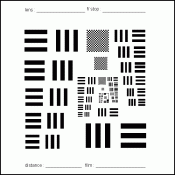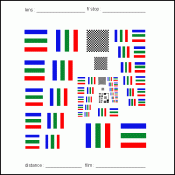Wayne, Edmunds' $119 USAF 1951 chart on glass, their item R38-257, is for testing relatively low magnification microscope objectives and macro lenses at short distances, not for testing more usual kinds of lenses at normal distances. I didn't know you were a microscopist too.
Yes, for the usual kinds of lenses focused distance is very important. At the recommended distance, (group/element) translates directly to resolution on film. At other distances you have to do calculations, can't just look up in a table. For testing at distance you probably want Edmund's R80-001, priced at $18.95. Or call them, explain what you want to accomplish, and ask for advice on what to buy and how to use it.
Claire, I've used a target with fixed spacing -- a stage micrometer with 100 marks/mm -- for go/no go testing on macro lenses. Your procedure is good for that "at distance," a bit tedious for finding out what a lens can't do at various distances. And if Wayne really wants to test macro lenses, where what a lens can do at a magnification is of interest, there's really no alternative to using a target with many scales, e.g., a USAF 1951.
The USAF 1951 has other advantages over, e.g., my little stage micrometer. It hqs sets of targets at right angles, makes astigmatism very visible. And its targets have three black bars, makes spurious resolution very easy to detect. With my stage micrometer, I had to count very carefully.
Cheers,
Dan













